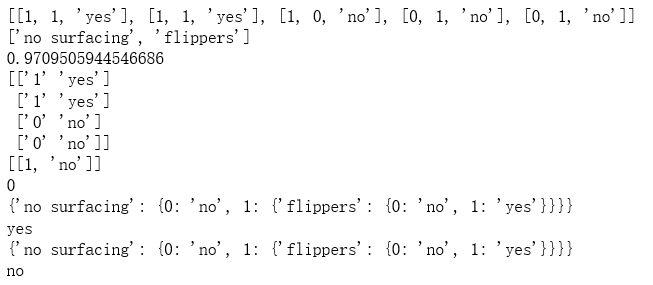吴裕雄 python 机器学习-DMT(1)
import numpy as np
import operator as op from math import log def createDataSet():
dataSet = [[1, 1, 'yes'],
[1, 1, 'yes'],
[1, 0, 'no'],
[0, 1, 'no'],
[0, 1, 'no']]
labels = ['no surfacing','flippers']
return dataSet, labels dataSet,labels = createDataSet()
print(dataSet)
print(labels) def calcShannonEnt(dataSet):
labelCounts = {}
for featVec in dataSet:
currentLabel = featVec[-1]
if(currentLabel not in labelCounts.keys()):
labelCounts[currentLabel] = 0
labelCounts[currentLabel] += 1
shannonEnt = 0.0
rowNum = len(dataSet)
for key in labelCounts:
prob = float(labelCounts[key])/rowNum
shannonEnt -= prob * log(prob,2)
return shannonEnt shannonEnt = calcShannonEnt(dataSet)
print(shannonEnt) def splitDataSet(dataSet, axis, value):
retDataSet = []
for featVec in dataSet:
if(featVec[axis] == value):
reducedFeatVec = featVec[:axis]
reducedFeatVec.extend(featVec[axis+1:])
retDataSet.append(reducedFeatVec)
return retDataSet retDataSet = splitDataSet(dataSet,1,1)
print(np.array(retDataSet))
retDataSet = splitDataSet(dataSet,1,0)
print(retDataSet) def chooseBestFeatureToSplit(dataSet):
numFeatures = np.shape(dataSet)[1]-1
baseEntropy = calcShannonEnt(dataSet)
bestInfoGain = 0.0
bestFeature = -1
for i in range(numFeatures):
featList = [example[i] for example in dataSet]
uniqueVals = set(featList)
newEntropy = 0.0
for value in uniqueVals:
subDataSet = splitDataSet(dataSet, i, value)
prob = len(subDataSet)/float(len(dataSet))
newEntropy += prob * calcShannonEnt(subDataSet)
infoGain = baseEntropy - newEntropy
if (infoGain > bestInfoGain):
bestInfoGain = infoGain
bestFeature = i
return bestFeature bestFeature = chooseBestFeatureToSplit(dataSet)
print(bestFeature) def majorityCnt(classList):
classCount={}
for vote in classList:
if(vote not in classCount.keys()):
classCount[vote] = 0
classCount[vote] += 1
sortedClassCount = sorted(classCount.items(), key=op.itemgetter(1), reverse=True)
return sortedClassCount[0][0] def createTree(dataSet,labels):
classList = [example[-1] for example in dataSet]
if(classList.count(classList[0]) == len(classList)):
return classList[0]
if len(dataSet[0]) == 1:
return majorityCnt(classList)
bestFeat = chooseBestFeatureToSplit(dataSet)
bestFeatLabel = labels[bestFeat]
myTree = {bestFeatLabel:{}}
del(labels[bestFeat])
featValues = [example[bestFeat] for example in dataSet]
uniqueVals = set(featValues)
for value in uniqueVals:
subLabels = labels[:]
myTree[bestFeatLabel][value] = createTree(splitDataSet(dataSet, bestFeat, value),subLabels)
return myTree myTree = createTree(dataSet,labels)
print(myTree) def classify(inputTree,featLabels,testVec):
for i in inputTree.keys():
firstStr = i
break
secondDict = inputTree[firstStr]
featIndex = featLabels.index(firstStr)
key = testVec[featIndex]
valueOfFeat = secondDict[key]
if isinstance(valueOfFeat, dict):
classLabel = classify(valueOfFeat, featLabels, testVec)
else:
classLabel = valueOfFeat
return classLabel featLabels = ['no surfacing', 'flippers']
classLabel = classify(myTree,featLabels,[1,1])
print(classLabel) import pickle def storeTree(inputTree,filename):
fw = open(filename,'wb')
pickle.dump(inputTree,fw)
fw.close() def grabTree(filename):
fr = open(filename,'rb')
return pickle.load(fr) filename = "D:\\mytree.txt"
storeTree(myTree,filename)
mySecTree = grabTree(filename)
print(mySecTree) featLabels = ['no surfacing', 'flippers']
classLabel = classify(mySecTree,featLabels,[0,0])
print(classLabel)

吴裕雄 python 机器学习-DMT(1)的更多相关文章
- 吴裕雄 python 机器学习-DMT(2)
import matplotlib.pyplot as plt decisionNode = dict(boxstyle="sawtooth", fc="0.8" ...
- 吴裕雄 python 机器学习——分类决策树模型
import numpy as np import matplotlib.pyplot as plt from sklearn import datasets from sklearn.model_s ...
- 吴裕雄 python 机器学习——回归决策树模型
import numpy as np import matplotlib.pyplot as plt from sklearn import datasets from sklearn.model_s ...
- 吴裕雄 python 机器学习——线性判断分析LinearDiscriminantAnalysis
import numpy as np import matplotlib.pyplot as plt from matplotlib import cm from mpl_toolkits.mplot ...
- 吴裕雄 python 机器学习——逻辑回归
import numpy as np import matplotlib.pyplot as plt from matplotlib import cm from mpl_toolkits.mplot ...
- 吴裕雄 python 机器学习——ElasticNet回归
import numpy as np import matplotlib.pyplot as plt from matplotlib import cm from mpl_toolkits.mplot ...
- 吴裕雄 python 机器学习——Lasso回归
import numpy as np import matplotlib.pyplot as plt from sklearn import datasets, linear_model from s ...
- 吴裕雄 python 机器学习——岭回归
import numpy as np import matplotlib.pyplot as plt from sklearn import datasets, linear_model from s ...
- 吴裕雄 python 机器学习——线性回归模型
import numpy as np from sklearn import datasets,linear_model from sklearn.model_selection import tra ...
随机推荐
- Css实战第二天小结
清除浮动的四种方式: 1.1 给父盒子设置一个高度: 1.2 Clear:both; 1.3 Overflow:hidden; 1.4 使用伪元素 .clearfix:befo ...
- CS229 5.用正则化(Regularization)来解决过拟合
1 过拟合 过拟合就是训练模型的过程中,模型过度拟合训练数据,而不能很好的泛化到测试数据集上.出现over-fitting的原因是多方面的: 1) 训练数据过少,数据量与数据噪声是成反比的,少量数据导 ...
- HTTP请求返回值所代表的含义
一些常见的状态码为: 200 - 服务器成功返回网页(表示请求成功) 404 - 请求的网页不存在(可能是网络的问题,也可能是网页没办法访问不代表网页不存在) 503 - 服务器超时(服务器故障) 下 ...
- [SDOI2016]生成魔咒(后缀自动机)
/* 水题, 根据性质做就行, nq不会对答案产生贡献, 那么只算p的贡献就好了 */ #include<cstdio> #include<algorithm> #includ ...
- 输入框占位符placeholder
占位符placeholder的益处不用多说,但是很不幸的是,在IE8之前的浏览器里是无法实现placeholder这一属性的,所以在需要兼容IE8之前的浏览器的情况下,我们不得不想办法模拟实现plac ...
- Es6入门解构
变量解构赋值:数组和对象中提取值,对变量进行赋值 1️⃣模式匹配:只要等号左右两边的模式相同,左边的变量就会被赋予对应的值 2️⃣不完全解构:等号左边的模式匹配等号右边数组的部分 默认值:解构赋值允许 ...
- 20165205 2017-2018-2 《Java程序设计》第六周学习总结
20165205 2017-2018-2 <Java程序设计>第六周学习总结 教材学习内容总结 String类 String对象(常量,对象) 字符串并置(结果仍是常量) 常用方法 len ...
- uva-270-排序
题意:很多个点,问,最多有多少个点在同一条直线上 #include <algorithm> #include <iostream> #include <string> ...
- 这个开挂一般的工具,承包你所有的PPT
本文转自知乎 作者:挖数 ----------------------------------------------------- 俗话说,办公有三宝,PPT.Word 和 Excel.后边两个大家 ...
- 《算法》第一章部分程序 part 2
▶ 书中第一章部分程序,加上自己补充的代码,包括简单的计时器,链表背包迭代器,表达式计算相关 ● 简单的计时器,分别记录墙上时间和 CPU 时间. package package01; import ...
